Hoffa, Teamsters played key roles in growth of Las Vegas
Nearly four decades after Jimmy Hoffa vanished, his ghost stays pretty active.
Every few years, it seems, a new theory emerges about the final resting place of the Teamster Union titan’s body. The name has become part of American mythology. And just last week, PBS devoted an episode of “History Detectives: Special Investigations” to Hoffa’s Houdini act.
Wednesday marks the 39th anniversary of Hoffa’s disappearance from the parking lot of the Machus Red Fox restaurant in suburban Detroit. On July 30, 1975, Hoffa was scheduled for a sit-down with Tony Provenzano of New Jersey and Anthony Giacalone of Detroit, mob bosses who held a death grip on the Teamsters. They never showed for the meeting and had solid alibis. Hoffa, who had been talking to a grand jury and attempting to muscle his way back to prominence in the labor organization, was never seen again.
But it’s not for a lack of searching. The FBI and mob experts great and small have sifted for suspects in his murder and the whereabouts of his body. Investigative journalist and author Dan Moldea, whose groundbreaking 1978 book “The Hoffa Wars: The Rise and Fall of Jimmy Hoffa” remains an authoritative source on the subject 35 years after its publication, still finds himself cutting through the myths about the man.
Take the idea Hoffa remained independent of the mob, for instance.
“Hoffa grew up in a very tough time in labor history in Detroit, which was a center of labor activity,” Moldea says. “In the process, he was corrupted.”
But it wasn’t a foregone conclusion for all labor bosses. Walter Reuther, president of the Detroit-based United Auto Workers from 1946 to 1970, didn’t fall prey to the city’s once formidable gangster culture.
“Walter Reuther was also in Detroit,” Moldea says. “He was a great and honest union man who led the United Auto Workers. The contrast between Walter Reuther and Jimmy Hoffa is very clear and present. One guy was a good guy, and one guy was a bad guy beholden to the mob. Hoffa was nothing more than a labor racketeer. The myth is that he kept them at arm’s distance. That is not true.”
Moldea’s research, which included interviews with key suspects in Hoffa’s disappearance, led him to conclude that the union boss was killed because he was willing to expose the gangsters who had benefited his career. Like Sam Giancana in Chicago and Johnny Rosselli in Las Vegas, Hoffa knew plenty — and that made him dangerous.
Ironically, Moldea observes, it was Hoffa’s murder and the mystery surrounding his disappearance that reinvigorated the Justice Department’s effort against organized crime during the Carter administration. That led to the dismantling of mob families across the country and a fracturing of the Teamsters powerful influence through its Central States Pension Fund loans.
Hoffa historians were no doubt intrigued by the publication in 2005 of the Charles Brandt book, “ ‘I Heard You Paint Houses’: Frank ‘The Irishman’ Sheeran and the Inside Story of the Mafia, the Teamsters, and the Last Ride of Jimmy Hoffa,” in which hitman Sheeran admitted the killing. But the trouble with Sheeran’s story is that it changed several times through the years. Although Moldea’s interviews led him to conclude the triggerman in the Hoffa murder was mobster Salvatore Briguglio, the author does believe Sheeran could have helped lure his friend Hoffa to his death.
In 2006, the FBI’s “Hoffex Memo” was published by the Detroit Free Press. It doesn’t endorse Sheeran’s version of events. The Bureau concluded that Hoffa was murdered because of his attempt to return to power and regain control of union’s pension fund.
Why spend part of a perfectly good Sunday thinking about Jimmy Hoffa? Although a legenday figure to a generation of working people, he was a mobbed-up labor racketeer and a convicted felon. He was a man who is said to have ordered the murders of rivals and union reformers.
All true. But Hoffa and the behemoth labor organization he built, with its enormous pension fund investments, also played an integral role in raising Las Vegas from motor court roadside attraction into the city we see today.
Maybe that’s why Hoffa got so much respect here.
John L. Smith’s column appears Sunday, Tuesday, Wednesday, Thursday and Friday. Email him at Smith@reviewjournal.com or call 702-383-0295. Follow him on Twitter @jlnevadasmith.














